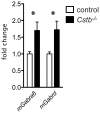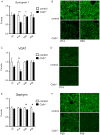Gene expression alterations in the cerebellum and granule neurons of Cstb(-/-) mouse are associated with early synaptic changes and inflammation
- PMID: 24586687
- PMCID: PMC3937333
- DOI: 10.1371/journal.pone.0089321
Gene expression alterations in the cerebellum and granule neurons of Cstb(-/-) mouse are associated with early synaptic changes and inflammation
Abstract
Progressive myoclonus epilepsy of Unverricht-Lundborg type (EPM1) is an autosomal recessively inherited neurodegenerative disease, manifesting with myoclonus, seizures and ataxia, caused by mutations in the cystatin B (CSTB) gene. With the aim of understanding the molecular basis of pathogenetic events in EPM1 we characterized gene expression changes in the cerebella of pre-symptomatic postnatal day 7 (P7) and symptomatic P30 cystatin B -deficient (Cstb(-/-) ) mice, a model for the disease, and in cultured Cstb(-/-) cerebellar granule cells using a pathway-based approach. Differentially expressed genes in P7 cerebella were connected to synaptic function and plasticity, and in cultured cerebellar granule cells, to cell cycle, cytoskeleton, and intracellular transport. In particular, the gene expression data pinpointed alterations in GABAergic pathway. Electrophysiological recordings from Cstb(-/-) cerebellar Purkinje cells revealed a shift of the balance towards decreased inhibition, yet the amount of inhibitory interneurons was not declined in young animals. Instead, we found diminished number of GABAergic terminals and reduced ligand binding to GABAA receptors in Cstb(-/-) cerebellum. These results suggest that alterations in GABAergic signaling could result in reduced inhibition in Cstb(-/-) cerebellum leading to the hyperexcitable phenotype of Cstb(-/-) mice. At P30, the microarray data revealed a marked upregulation of immune and defense response genes, compatible with the previously reported early glial activation that precedes neuronal degeneration. This further implies the role of early-onset neuroinflammation in the pathogenesis of EPM1.
Conflict of interest statement
Figures




Similar articles
-
The Roles of Cystatin B in the Brain and Pathophysiological Mechanisms of Progressive Myoclonic Epilepsy Type 1.Cells. 2024 Jan 16;13(2):170. doi: 10.3390/cells13020170. Cells. 2024. PMID: 38247861 Free PMC article. Review.
-
Brain inflammation is accompanied by peripheral inflammation in Cstb -/- mice, a model for progressive myoclonus epilepsy.J Neuroinflammation. 2016 Nov 28;13(1):298. doi: 10.1186/s12974-016-0764-7. J Neuroinflammation. 2016. PMID: 27894304 Free PMC article.
-
Abnormal microglial activation in the Cstb(-/-) mouse, a model for progressive myoclonus epilepsy, EPM1.Glia. 2015 Mar;63(3):400-11. doi: 10.1002/glia.22760. Epub 2014 Oct 18. Glia. 2015. PMID: 25327891
-
Progressive Myoclonus Epilepsy: Unverricht-Lundborg Disease.In: Noebels JL, Avoli M, Rogawski MA, Vezzani A, Delgado-Escueta AV, editors. Jasper's Basic Mechanisms of the Epilepsies. 5th edition. New York: Oxford University Press; 2024. Chapter 51. In: Noebels JL, Avoli M, Rogawski MA, Vezzani A, Delgado-Escueta AV, editors. Jasper's Basic Mechanisms of the Epilepsies. 5th edition. New York: Oxford University Press; 2024. Chapter 51. PMID: 39637163 Free Books & Documents. Review.
-
Gene-Expression Profiling Suggests Impaired Signaling via the Interferon Pathway in Cstb-/- Microglia.PLoS One. 2016 Jun 29;11(6):e0158195. doi: 10.1371/journal.pone.0158195. eCollection 2016. PLoS One. 2016. PMID: 27355630 Free PMC article.
Cited by
-
The Roles of Cystatin B in the Brain and Pathophysiological Mechanisms of Progressive Myoclonic Epilepsy Type 1.Cells. 2024 Jan 16;13(2):170. doi: 10.3390/cells13020170. Cells. 2024. PMID: 38247861 Free PMC article. Review.
-
Age-Dependent Reduction in the Expression Levels of Genes Involved in Progressive Myoclonus Epilepsy Correlates with Increased Neuroinflammation and Seizure Susceptibility in Mouse Models.Mol Neurobiol. 2022 Sep;59(9):5532-5548. doi: 10.1007/s12035-022-02928-x. Epub 2022 Jun 22. Mol Neurobiol. 2022. PMID: 35732865
-
Microglial phagocytosis dysfunction in the dentate gyrus is related to local neuronal activity in a genetic model of epilepsy.Epilepsia. 2020 Nov;61(11):2593-2608. doi: 10.1111/epi.16692. Epub 2020 Sep 17. Epilepsia. 2020. PMID: 32940364 Free PMC article.
-
Insights into the Genetic Profile of Two Siblings Affected by Unverricht-Lundborg Disease Using Patient-Derived hiPSCs.Cells. 2022 Nov 4;11(21):3491. doi: 10.3390/cells11213491. Cells. 2022. PMID: 36359887 Free PMC article.
-
Large-scale gene expression changes in APP/PSEN1 and GFAP mutation models exhibit high congruence with Alzheimer's disease.PLoS One. 2024 Jan 18;19(1):e0291995. doi: 10.1371/journal.pone.0291995. eCollection 2024. PLoS One. 2024. PMID: 38236817 Free PMC article.
References
-
- Kälviäinen R, Khyuppenen J, Koskenkorva P, Eriksson K, Vanninen R, et al. (2008) Clinical picture of EPM1-Unverricht-Lundborg disease. Epilepsia 49: 549–556. - PubMed
-
- Lalioti MD, Scott HS, Buresi C, Rossier C, Bottani A, et al. (1997) Dodecamer repeat expansion in cystatin B gene in progressive myoclonus epilepsy. Nature 386: 847–851. - PubMed
-
- Pennacchio LA, Lehesjoki AE, Stone NE, Willour VL, Virtaneva K, et al. (1996) Mutations in the gene encoding cystatin B in progressive myoclonus epilepsy (EPM1). Science 271: 1731–1734. - PubMed
-
- Pennacchio LA, Bouley DM, Higgins KM, Scott MP, Noebels JL, et al. (1998) Progressive ataxia, myoclonic epilepsy and cerebellar apoptosis in cystatin B-deficient mice. Nat Genet 20: 251–258. - PubMed
Publication types
MeSH terms
Substances
LinkOut - more resources
Full Text Sources
Other Literature Sources
Molecular Biology Databases
Research Materials
Miscellaneous

